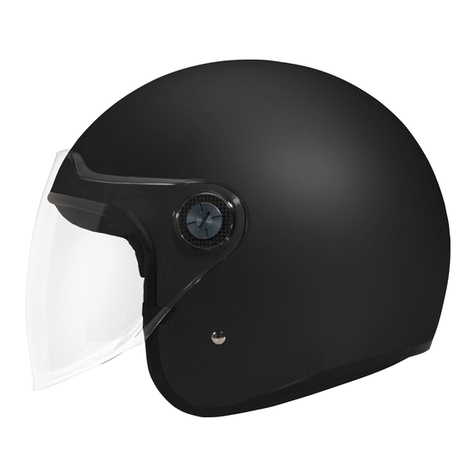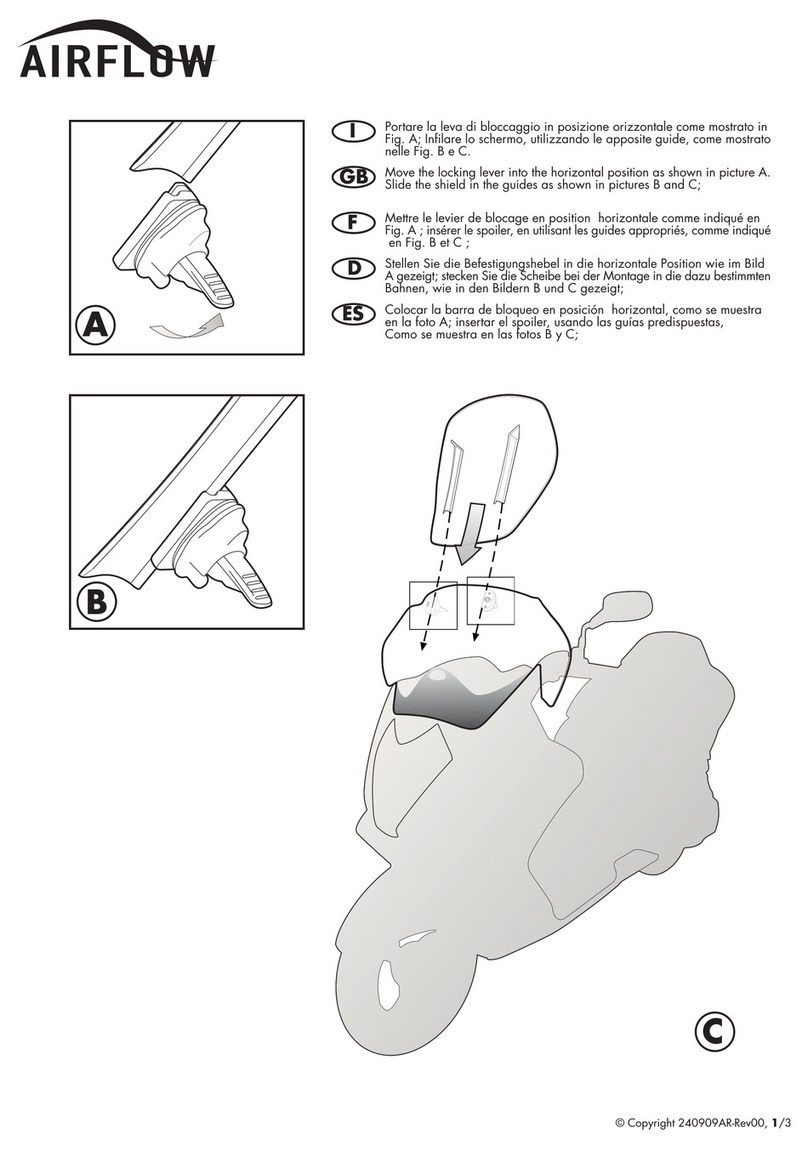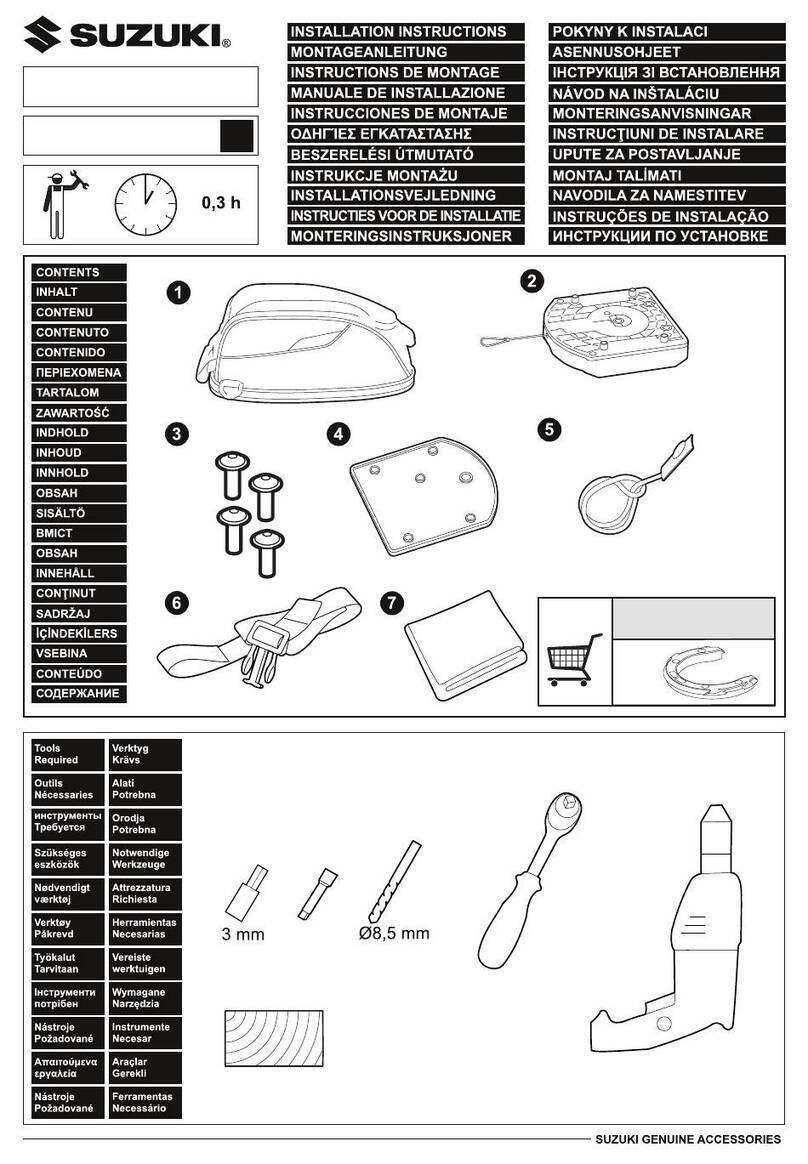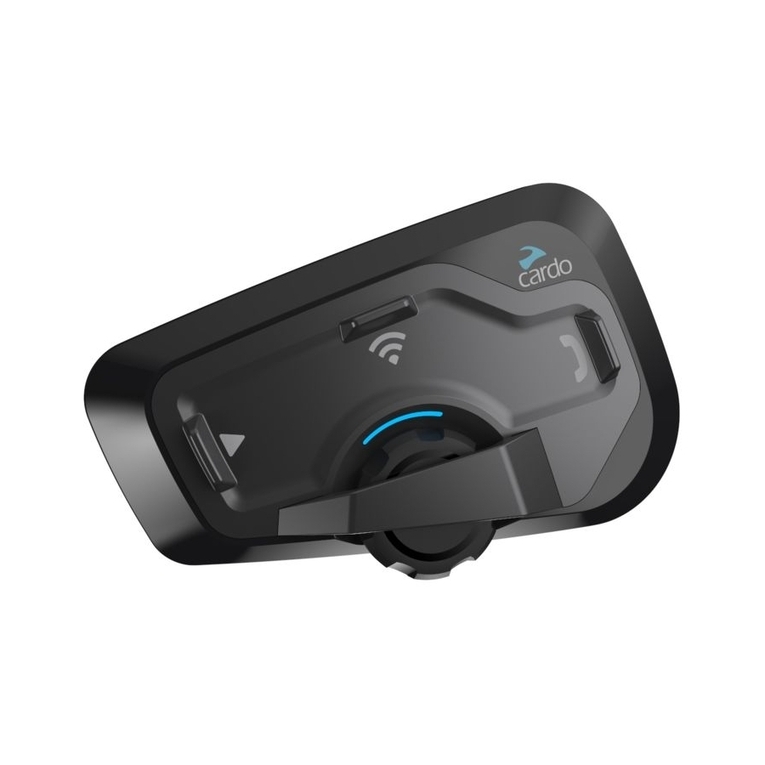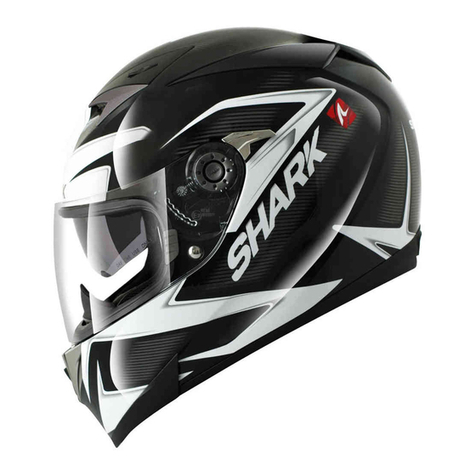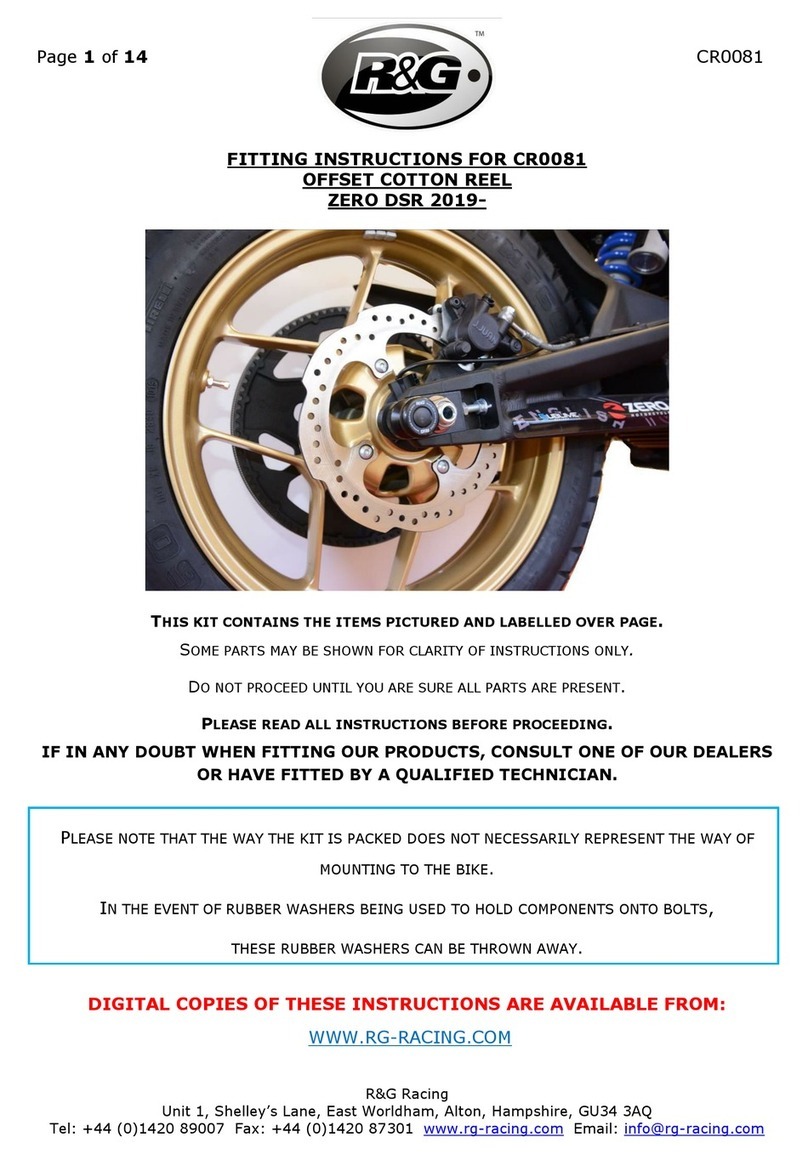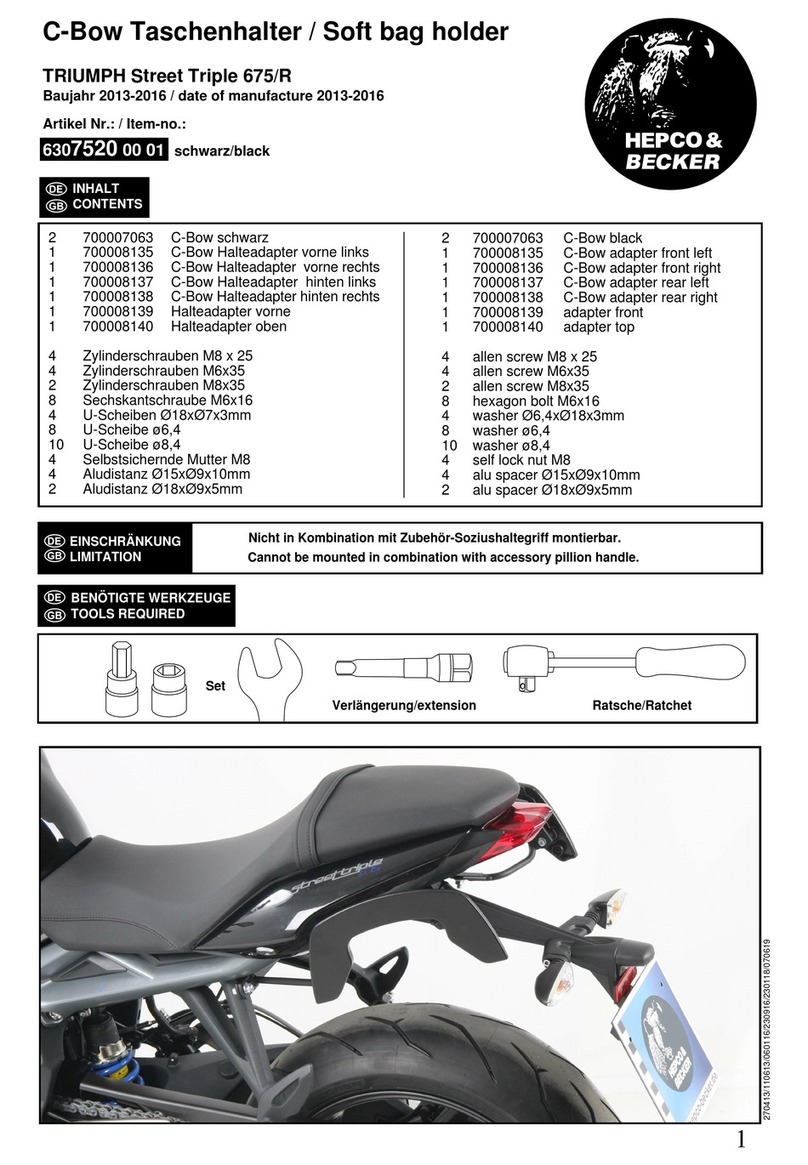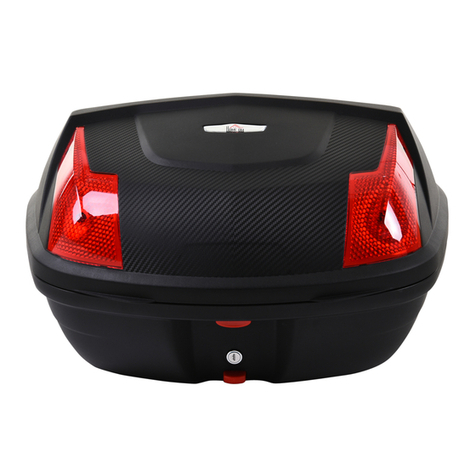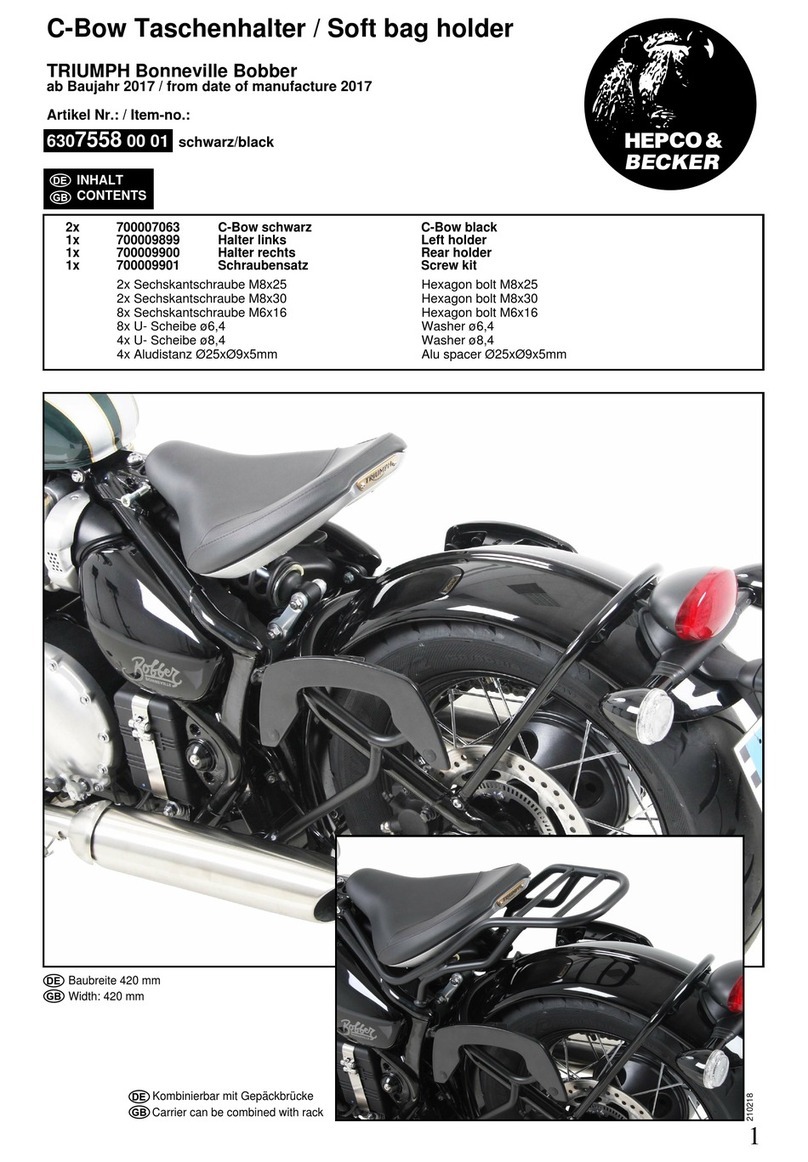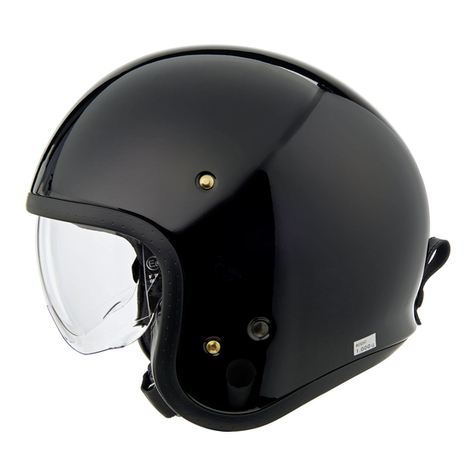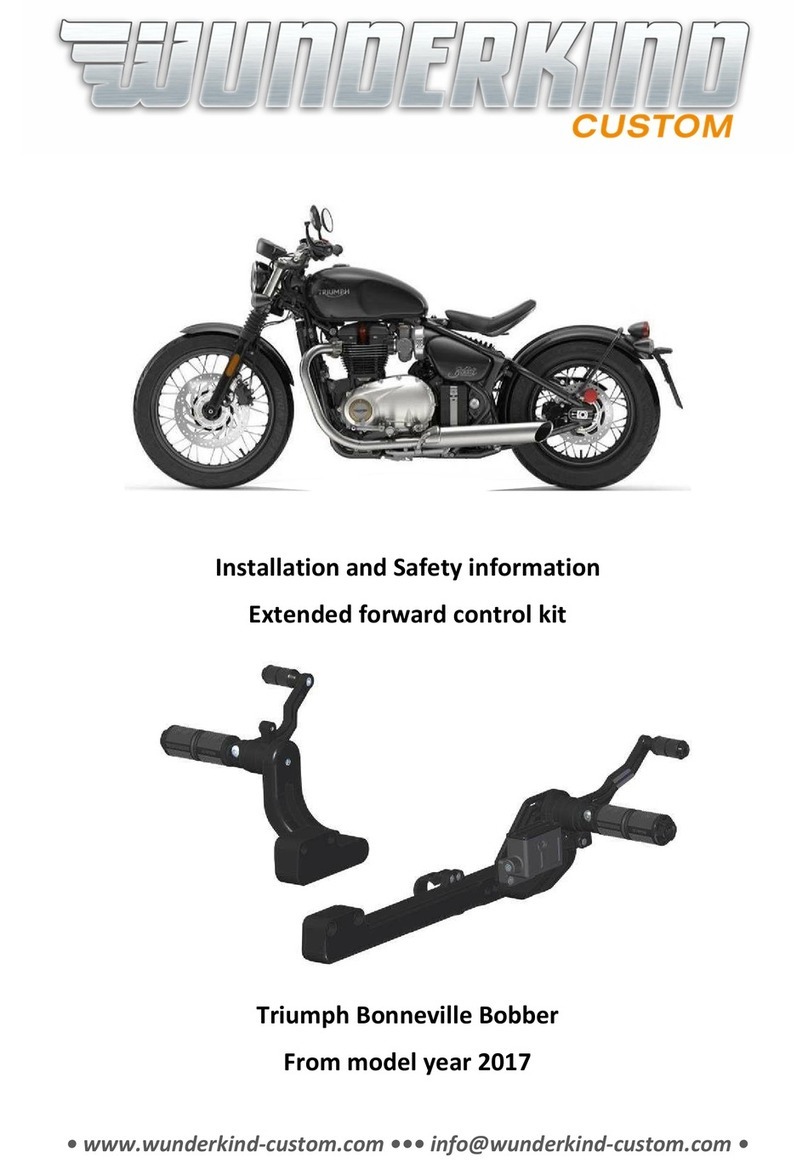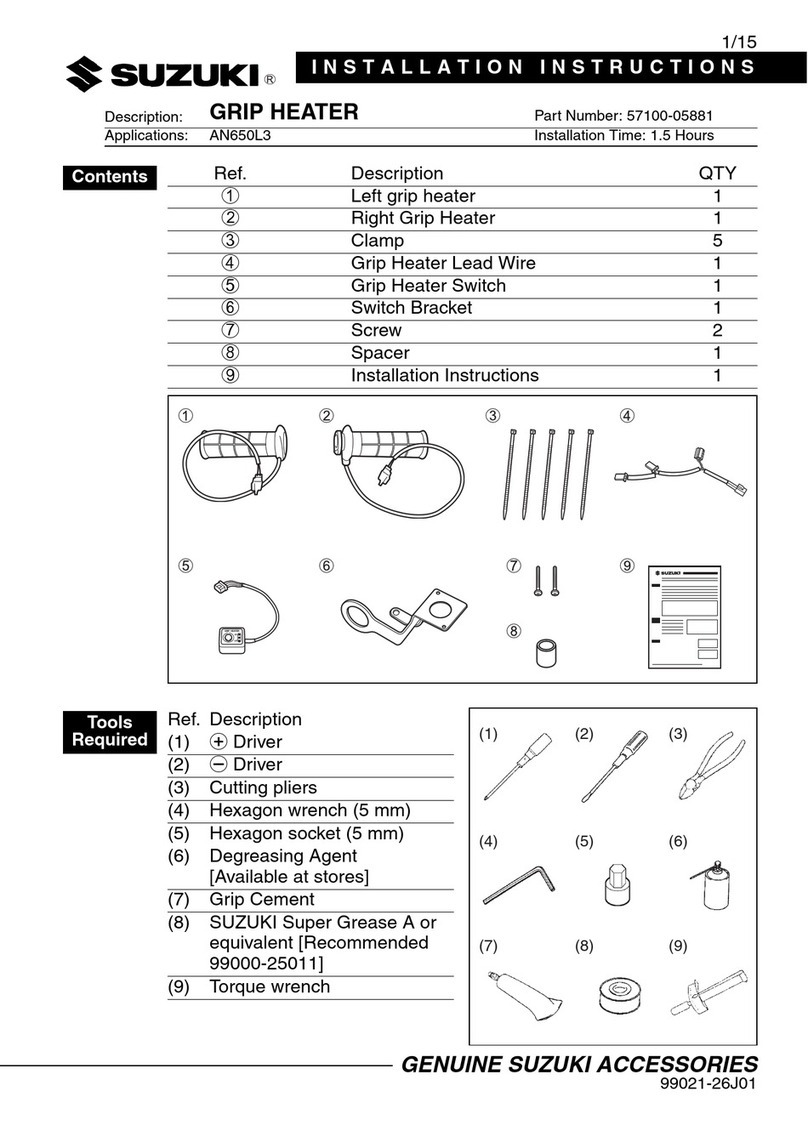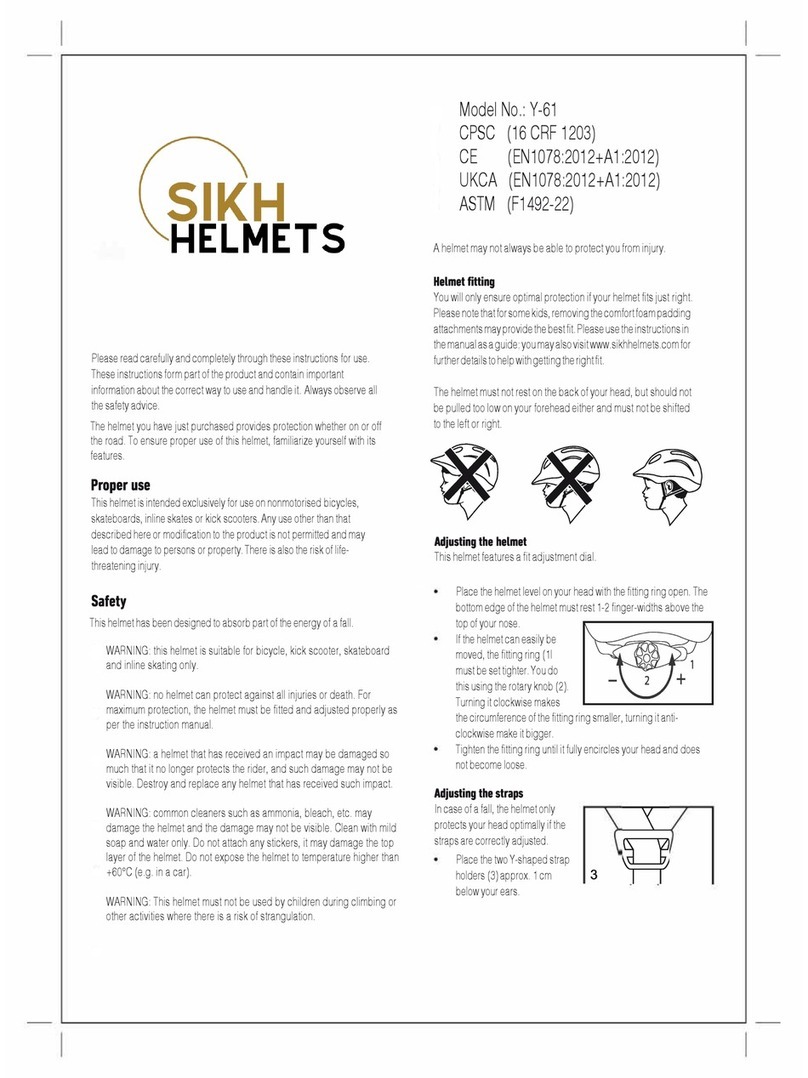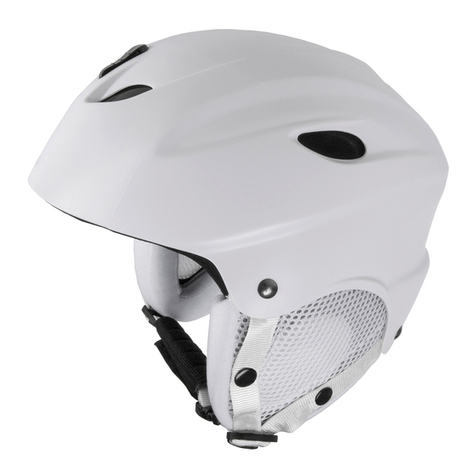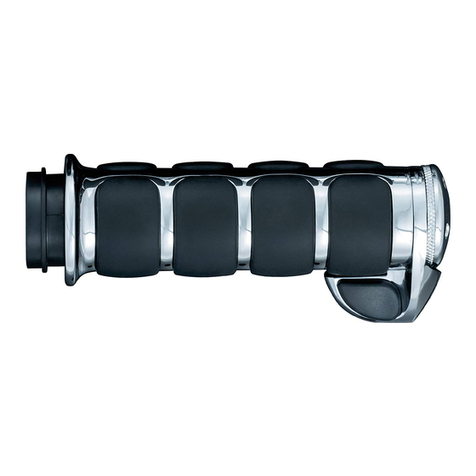Filmer 46.604 User manual

Produktinformation & Gebrauchsanweisung
Helm für Radfahrer
Diedrich Filmer GmbH
Jeringhaver Gast 5
D - 26316 Varel
Tel.: +49 (0) 4451 1209-0
www.filmer.de
Helmprobe (Abb.1):
Optimalen Schutz erreichen Sie nur mit optimalem Sitz. Probieren Sie verschiedene Größen und
wählen Sie die Größe, die fest und komfortabel auf dem Kopf sitzt. Der Helm sollte so auf dem
Kopf positioniert werden, dass der beabsichtigte Schutz erfüllt wird. Er sollte so aufgesetzt
werden, dass er die Stirn schützen kann und nicht zu weit nach hinten rutscht (s. Abb.).
Anpassung des Innenteils (Abb. 2):
Überprüfen Sie den festen Sitz durch leichtes Kopfschütteln mit offenem Kinngurt. Wenn sich
dabei der Helm leicht verschiebt, muss der Verstellring (1) enger eingestellt werden.
Durch Betätigung des Drehknopfs (2) wird das Rastsystem verstellt.
Durch Drehen nach rechts wird der Gurtumfang verkleinert und durch Drehen nach links vergrößert.
Anpassung und Einstellung der Gurtbänder (Abb. 3):
Im Falle eines Sturzes schützt der Helm Ihren Kopf nur optimal, wenn die Gurtbänder richtig eingestellt und straff
geschlossen sind. Der Kinnriemen ist während der Nutzung des Helmes zu schließen.
1. Gurtstraffer E bis zum linken bzw. rechtem Ohr hochschieben. Der Riemen darf das Ohr nicht bedecken.
2. Gurtschloss B schließen. Gurtschloss darf nicht auf dem Kinn liegen.
3. Bei geöffnetem Mund sollte der Kinnriemen C gegen das Kinn drücken.
4. Gurt spannen durch Ziehen der beiden Gurtenden. Riemen und Schloss müssen sowohl
komfortabel als auch fest eingestellt werden.
5. Nach dem Einstellen der Riemen kann das Gurtende mit der Halterung D gesichert werden.
Anbau der Sonnenblende (Schirm) (Abb. 4):
Der Schirm kann bei Bedarf in die am Helm eingelassenen Öffnungen eingesteckt werden.
Vorsicht beim Anbau, da die Öffnungen am Helm nicht ersetzt werden können und ein übermäßi-
ges Verwenden die Öffnungen weitet.
Gebrauchsanleitung und Pflege:
- Nach einem schweren Sturz oder einem heftigen Stoß muss der Helm, auch wenn keine
Schäden feststellbar sind, ausgewechselt werden.
- Unter dem Helm sollte kein Kopftuch, hochgebundenes Haar o.ä. getragen werden.
Verletzungsgefahr!
- Der Helm darf nicht bemalt oder beklebt werden. Farbe und Kleber kann Bestandteile enthalten, welche die Stabilität
des Helmes und damit die Schutzwirkung mindern.
- Der Helm sollte keinen Temperaturen über 60°C ausgesetzt werden, da er sonst schützende Eigenschaften verlieren
könnte. Bitte den Helm nicht in der Nähe von Heizkörpern oder in der Sonne hinter Glasscheiben (z.B. im Auto)
aufbewahren.
- Die Helmschale, die herausnehmbaren Pads und den Verstellring sowie der Gurt kann mit lauwarmen Wasser und
milder Seifenlösung gereinigt werden. Pads und Verstellring kann hierzu aus dem Helm entnommen werden. An-
schließend sollten die Innenteile sorgfältig positioniert und die Passform und der gute Sitz des Helmes kontrolliert
werden. Verwenden Sie zur Reinigung keine Lösungsmittel, wie z.B. Verdünnung oder Ähnliches.
- Spätestens 7 Jahre nach Produktionsdatum (siehe Helminnenseite) muss der Helm ersetzt werden.
- Der Helm kann mit dem Hausmüll (Restmüll) entsorgt werden.
Sicherer Gebrauch:
- Dieser Helm ist zur Nutzung beim Fahrradfahren, Tretrollerfahren, Inlineskaten und Rollschuhlaufen, um vor den Folgen eines Unfalles zu schützen. Für andere Sportarten
wie Ski-, Motorrad und Mofa fahren ist er nicht geeignet.
- Bitte verändern bzw. entfernen Sie keine der Originalteile des Helms, solange dies nicht ausdrücklich vom Hersteller empfohlen wurde. Es besteht die Gefahr von
Verletzungen.
- Ein Fahrradhelm für Kinder muss von einem Erwachsenen eingestellt werden.
- Ein Fahrradhelm kann nicht vor Verletzungen schützen.
Technische Spezifikationen:
Artikel: Fahrradhelm
Art.-Nr.: 46.604 (FCB-11-3 ), 46.606 (FCB-11-3), 46.610 (FCB-14), 46.611 (FCB-14), 46.613 (FCB-14), 46.616 (FCB-14), 74.610 (FCB-9A), 74.611 (FCB-9A)
Größe: für Kopfumfang von 52 - 56 cm (46.610, 46.611, 46.613, 46.616, 74.610, 74.611), Gewicht: 232 g
für Kopfumfang von 55 - 59 cm (46.604, 46.606), Gewicht: 264 g
Warnhinweis:
Der Helm ist nicht zum Klettern oder für andere Aktivitäten zu verwenden, wenn ein Risiko besteht sich zu strangulieren falls sich das Kind verfängt.
Prüfinstitut:
TÜV Rheinland LGS Products GmbH, Tillystraße 2, 90431 Nürnberg
Prüfstellen Nummer: 0197
Die Konformitätserklärung haben wir auf unserer Homepage www.filmer.de für Sie zur Verfügung gestellt.
✔✗✗
1
2
B
B
C
E
D
Abb. 2
Abb. 4
Abb.1
Abb. 3

Bicycle Helmet
Product Information & Instructions for Use
Diedrich Filmer GmbH
Jeringhaver Gast 5
D - 26316 Varel
Tel.: +49 (0) 4451 1209-0
www.filmer.de
Trying the helmet on (ill.1):
Perfect protection is only possible with a perfect fit.
Try on different sizes and choose the size that is firm and feels comfortable on your head. The
helmet should be positioned on your head in such a way that the intended protection is provided.
It should be worn so that it protects the forehead and is not able to slip back too far (s. Ill.)
Adapting the inner part (ill. 2):
Check that it is firmly positioned by shaking your head slightly when the chin strap is open.
Should the helmet move slightly, the adjusting ring (1) is to be adjusted so that it is tighter.
The locking system is adjusted by turning the rotary knob (2).
A rotation to the right shortens the girth of the webbing strap and it is lengthened by rotating the knob to the left.
Fitting and adjusting the webbing straps (ill. 3):
Should you have an accident, the helmet is only able to protect your head perfectly if the webbing straps are correctly
adjusted and closed tightly. The chin strap is to be kept closed when you wear the helmet.
1. Push the strap tensioner E up to the left and the right ear respectively. The strap is not to cover your ear.
2. Close webbing buckle B. The webbing buckle is not to be positioned on your chin.
3. When you open your mouth, the chin strap C should press against your chin.
4. Tighten the webbing straps well by pulling both ends of the webbing straps. The strap and the
buckle should be comfortable and tightly adjusted.
5. After the straps have been adjusted, the end of the webbing strap can be secured using the
holder D.
Mounting the sun visor (shield) (ill. 4):
If required, the shield can be mounted by it being inserted in the openings that have been set in
the helmet.
Mount with care as the openings on the helmet cannot be replaced and excessive use can result
in them being widened.
Instructions for use and care:
- The helmet is to be replaced after a serious accident or a severe impact, even if no damage to
the helmet can be detected.
- A headscarf or tied up hair, etc. is not to be worn under the helmet. Risk of injury!
- The helmet is not to be painted on or have stickers placed on it. Paints and adhesives can include components that
reduce the stability of the helmet and therefore the protective effect.
- The helmet is not to be exposed to temperatures exceeding 60ºC as it could otherwise have reduced protective
properties. Do not store the helmet close to radiators or behind panes of glass in the sun (e.g. in the car).
- The helmet shell, the removable pads, the adjusting ring and the strap webbing can be cleaned using tepid water and
a mild soap solution. The pads and the adjusting ring can be removed from the helmet for this purpose. The inner
parts should then be carefully positioned and the fit and good positioning of the helmet should be checked. Do not
clean the helmet using solvents, e.g. thinners or similar.
- The helmet is to be replaced 7 years after the production date (see inside the helmet) at the latest.
- The helmet can be disposed of in the household waste (residual waste).
Safe use:
- This helmet is designed for use as a form of protection against accidents when cycling and using pedal scooters, inline skates or roller skates. It is not suitable for other
types of sport such as skiing, motorcycling and riding mopeds.
- Please do not modify or remove any of the original parts of the helmet should this not be expressly recommended by the manufacturer. There is a risk of injury otherwise.
- A bicycle helmet for children is to be adjusted by an adult.
- A bicycle helmet cannot provide protection against injuries.
Technical specifications:
Article: Bicycle helmet
Art.-Nos: 46.604 (FCB-11-3 ), 46.606 (FCB-11-3), 46.610 (FCB-14), 46.611 (FCB-14), 46.613 (FCB-14), 46.616 (FCB-14), 74.610 (FCB-9A), 74.611 (FCB-9A)
Sizes: for a head circumference of 52-56 cm (46.610, 46.611, 46.613, 46.616, 74.610, 74.611), weight: 232 g
for a head circumference of 55-59 cm (46.604, 46.606), weight: 264 g
Warning:
The helmet is not to be worn when climbing or for other activities where there is a risk of strangulation should the child become entangled.
Testing institute:
TÜV Rheinland LGS Products GmbH, Tillystraße 2, 90431 Nürnberg (Nuremberg)
Testing body number: 0197
We have made the Certificate of Conformity available on our website: www.filmer.de.
✔✗✗
1
2
B
B
C
E
D
ill. 2
ill. 4
ill.1
ill. 3
This manual suits for next models
10
Table of contents
Languages:

